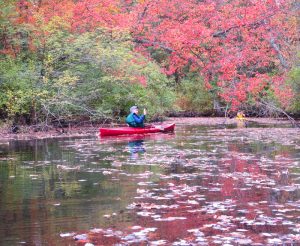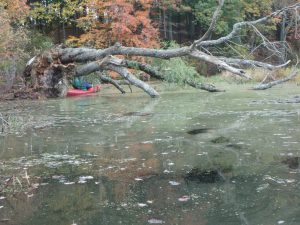Water Closet for November 3, 2017
[pullquote]”One of the delights this fall are the female winterberry bushes loaded with shiny Chinese-red clusters of blueberry-sized fruits which seems redder and more numerous this year”[/pullquote] The beavers have the river passable for paddlers despite only five inches of rain since the end of July. Their dams, one encountered every mile or so, keep the water from draining quickly to the sea. On the Watershed Association’s Trick or Treat for Volunteers afternoon1, a warm one, Saturday, October 21, the old Closeteer paddled Leon Rubchinuk’s new canoe from Farnsworth Landing to Peabody Street Landing. A hundred pounds of ballast stowed forward provided trim. He took three and one half hours without exerting himself except when passing over four beaver dams with heads of about 4, 2, 3 and 1 feet. He had to step out on two dams and lower the canoe down on a line. Two were scooted over by shifting his weight back and forth. It was slow going through rafts of dying water plants between dams over half of the five miles paddled. He imagined at times he was in the Sargasso Sea. It sounds hard but wasn’t; the late summer-fall phenomenon of odorless eutrophication2 just slowed him down a bit. The river water was still relatively warm for mid-October. There hadn’t even been a hard frost here yet.

Debris draped kayaker’s paddle above Ipswich River water filled with dying plants floating on and suspended in the upper layers. The emergent wetland plants of the floodplain along the floodplain have turned brown. The upland trees above are still largely green even in late October. – Sandy Rubchinuk photo
The meandering river under a clear October sky was pleasant and peaceful despite the dying changes taking place in the water. Half the emergent herbaceous plants on the channel’s edges still had some green as they turn various shades of gray and brown. Many smart weeds were still green and with spikes of white and pink flowers. They constitute much of the watery road’s shoulders in many places. The reed-canary grass so common since it took over from the purple loosestrife in the last decade has been brown since late August. Until then the shoulder-high leaves were lush green. One of the delights this fall are the female winterberry bushes loaded with shiny Chinese-red clusters of blueberry-sized fruits which seems redder and more numerous this year. Their leaves are still dark green; a couple of bushes were passed on the edge of the river every hundred or so yards. After the leaves are gone winterberry branches are cut in December by many for Christmas decorations. On Halloween of this unusually warm fall the leaves may still be green. Here and there the ghostly gray vines of climbing hemp weed, twining up button bushes and swamp dogwood, gave the river a somber mood but not for long. The red maples along the floodplain still with leaves were in glorious shades of maroon, some had several shades of red, light to dark, in between. These glowed in the late afternoon sun. The maples more than made up for the lack of warm colors in the uplands this strange fall. The fall color show this year seems two weeks behind and much drought affected.

Kayaker photographed these arched red maples putting on a fall show along the Ipswich River. A low beaver dam can be seen in the background. – Judy Schneider photo
Many tree leaves are skipping the annual show and curling up to turn shades of gray or brown and then prematurely falling. Maybe it’s due to the drought and warm temperatures. In the river valley there was plenty of color thanks to the red maples, a few swamp oaks with yellow-green leaves, and the bright yellow-brown of hickory leaves. These trees along the river do not overwhelm with continuous color, but flare up at intervals below the greens of upland oaks and the dark year-round blue-greens of white pines. All that was seen by looking outward from the canoe underneath a blue October sky. The water below was murky with algae, fungi, and bacteria among dying floating Potamogeton, coon tail, and other submergent plants. Floating in the upper few inches on rafts of debris were bright green patches of filamentous algae shining in the sun. The shine was reflected off layers of tiny bubbles of oxygen from photosynthesis. The other gas, always high among rotting and burning things, was carbon dioxide, the unseen food for photosynthesis. The Closeteer liked the idea he was breathing the oxygen of green plants and algae even though we all do so all the time. Here he could see its pure bubbles. With a microscope and still platform he might have studied the many species of microorganisms in the water cloudy with plankton. He’d brought no sampling bottles.

Ipswich River water cloudy with organisms beneath a collapsed old willow felled by beavers. Blooms of algae, bacteria, and fungi fill the upper layers of long stretches of the river among dying plant debris. This occurs each late summer and early fall in slow flowing, warm water bodies. Many of our rivers and streams the last decade have been a series of impoundments behind beaver dams. – Sandy Rubchinuk photo
The larger organisms besides plants he admired were mallard ducks, black ducks, and wood ducks. On rounding almost every turn he spooked a dozen or two. It is gathering time for movements south. They were fattening up for long flights. On one of many still standing drowned red maple trunks a belted kingfisher perched watching the canoe’s approach. At about 100 yards it swooped away down river chattering as kingfishers do. The Closeteer expected to see it perched around the next turn perhaps waiting again as kingfishers and great blue herons often do. It was. Several herons stalking fish, solitary as they usually are outside of their rookeries, were spooked. They too flew down river to fish, only soon to be interrupted again. One beauty gracefully on great dark gray-blue wings flew low across river two hundred feet from the canoe. It dramatically defecated a long yellow stream. Was she just showing contempt for past human indignities or just lightening her load a pound for flight? Adults four feet tall weigh only eight pounds.

A new muskrat lodge, one of several seen, in the shallows just off the Ipswich River channel. Muskrats don’t use large sticks as do beavers. Their smaller homes are of soft plants and mud. – Judy Schneider photo
A more modest hero of the river who defecates underwater was never seen by the lone paddler on the trip. The beavers that have shaped our streams and small rivers since the mid-1990s and have retained the water much longer in the watershed generally go about their work without fanfare, no FACEBOOK posts for them. Now and then we see them swimming in the Ispwich River. signs are everywhere along the streams and out a hundred feet or so into the uplands that they usually avoid. Now is the time they are raising their dams in preparation for thick river ice. If you don’t have a canoe or kayak drive down to the Stream Team’s parklet on Logbridge Road, off Route 114, east of Market Basket, and admire the handsome recently renovated dam with a Hoover Dam shaped upriver arc with a four foot head. Stream Team photographer Elaine Gauthier meditates on a park bench just above the dam on Sunday mornings. A few weeks ago a colleague found her napping in her pew during Sunday service. The sound of water flowing over the dam is a lovely sermon no doubt promoting contentment and sleep. Do the beavers also love that sound? We know it is partly the sound of flowing water that instigates their dam building.
In her free time from work Elaine goes forth on area waters in her kayak with camera. At night she wears a miner’s light. Upon returning home she shares spectacular photos that celebrate the lights we landlubbers often miss. Get out there on the river Wilmington to Ipswich while the water is still relatively warm and see the changing colors for yourself.
1 The Ipswich River Watershed Association had staff members at each of four of the Middleton Stream Teams landing passing out candy, beer, an IRWA cap, gift certificates, and discount coupons to volunteers who stopped by in car or vessel.
2 Eutrophication is when dense plant and algae populations crowd each other out in water bodies with excessive nutrients, especially during periods of warm, slow-flowing water. These dying and death processes are a natural in many ponds, lakes, and beaver impoundments in late summer and early fall.
__________________________________________________________
WATER RESOURCE AND CONSERVATION INFORMATION
FOR MIDDLETON, BOXFORD AND TOPSFIELD
| Precipitation Data* for Month of: | July | Aug | Sept | Oct | |
| 30 Year Normal (1981 – 2010) Inches | 3.89 | 3.37 | 3.77 | 4.40 | |
| 2017 Central Watershed Actual | 3.43 | 1.22 | 2.44 | 2.8 as of Oct 27 | |
Ipswich R. Flow Rate (S. Middleton USGS Gage) in Cubic Feet/ Second (CFS):
For Oct 27, 2017 Normal . . . 18 CFS Current Rate . . .10.4 CFS
*Danvers Water Filtration Plant, Lake Street, Middleton is the source for actual precipitation data thru Sept.
——————————————————————
** Middleton Stream Team is the source of actual precipitation data for Oct…
Normals data is from the National Climatic Data Center.
THE WATER CLOSET is provided by the Middleton Stream Team: www.middletonstreamteam.org or <MSTMiddletonMA@gmail.com>


S Gas hello my website is S Gas
Icc IDM hello my website is Icc IDM
dj 2013 hello my website is dj 2013
atommie hello my website is atommie
tw mp4 hello my website is tw mp4
M430f hello my website is M430f
catur4d hello my website is catur4d
js混淆 hello my website is js混淆